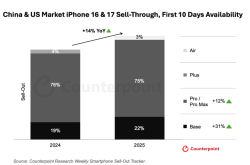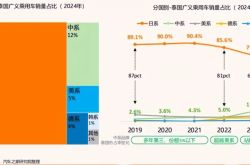Tencent Cloud Navigates Turbulent Waters in the Government Cloud Sector
![]() 06/16 2025
06/16 2025
![]() 849
849
The Chinese cloud computing market has evolved from a vast, untapped ocean of growth into a fiercely competitive red ocean, characterized by rigorous battles across technology, pricing, ecosystem development, and service quality. From virtual servers to AI-native architectures, and from resource leasing to industry intelligence, each wave of technological innovation reshapes the competitive landscape. Tencent Cloud, leveraging its extensive C-end ecosystem traffic inlets and natural synergies stemming from its social media roots, once firmly held the second position in the Chinese cloud market, establishing a near-dominant presence in the pan-internet sector.

However, recent financial reports and market dynamics reveal underlying concerns beneath its sizeable presence: sustained growth deceleration, an inadequate proportion of high-value customers, and underwhelming breakthroughs in the government and enterprise market. The former "king of internet cloud," renowned for its "connectivity" moat, now confronts unprecedented challenges from the dual pressures of industrial digitization's deep waters and the all-out technology race.
Since the beginning of this year, the Chinese cloud computing market has started to shift from "cloud adoption and data utilization" to "intelligent cloud empowerment." The competitive landscape has undergone significant changes: Alibaba Cloud maintains its lead with deep roots in the government and enterprise market and a robust self-developed technology ecosystem; Huawei Cloud accelerates its penetration across various industries with its comprehensive "cloud + AI + 5G" capabilities; and operator clouds (such as China Telecom's Tianyi Cloud and China Mobile's Mobile Cloud) capitalize on local resources and price advantages to grab market share (with a combined growth rate exceeding 35%). More crucially, there's a paradigm shift in technology: AI large models are driving the reconstruction of cloud infrastructure. While Tencent Cloud retains its share in advantageous fields like gaming, audio, and video, its market share in key industries such as manufacturing, energy, and government affairs remains below 15%, trailing far behind industry leaders.
The Ascendancy of "Ecosystem-Based Cloud Providers"
Tencent Cloud's early success was a natural outcome during the golden age of the consumer internet. When traditional enterprises were still evaluating the value of cloud computing and startups yearned for agile IT architectures, Tencent Cloud accurately positioned itself to meet the demands of the internet explosion era with its bundled model of "WeChat/QQ Ecosystem + Cloud Services." Amid high customer acquisition costs, it achieved bidirectional traffic guidance between B and C ends through traffic support plans (e.g., free traffic fees for WeChat Mini Program cloud development). When customers required rapid application development, it modularized its internal capabilities, such as QQ, payments, and security, and offered them as PaaS services. This seemingly effortless ascent was actually a strategic triumph of ecosystem collaboration and scenario-based positioning.
First, the "Traffic Lever" of the C2B Ecosystem.
Tencent Cloud transforms its consumer-end advantages into industry-end leverage. The WeChat Mini Program ecosystem boasts over 600 million monthly active users, and its "Cloud Development" platform seamlessly connects developers with users, lowering the threshold for small and medium-sized enterprises' digitization. In 2024, cloud service revenue from mini programs surged by 45% year-on-year, serving over 5.5 million merchants (Tencent Financial Report). In live e-commerce, Tencent Cloud's audio and video solutions supported a 210% increase in the daily number of live streams on video accounts, forming a closed loop of technology empowerment and traffic monetization. This "C-end nurturing B-end" model transforms ecological stickiness into a commercial moat.
Second, the "Agile Innovation" of Scenario-Based PaaS.
Tencent productizes and outputs its internal best practices. Based on IM, database (TDSQL), and audio-video (TRTC) capabilities honed from products with hundreds of millions of users like WeChat, QQ, and Honor of Kings, it encapsulates them into standardized PaaS services. Among them, TRTC commands 53% of the domestic audio-video cloud market (iResearch Consulting), supporting top applications like Bilibili and Xiaohongshu. When customers need to swiftly launch social or gaming functions, Tencent Cloud offers "out-of-the-box" components, shortening product development cycles by over 60%. Technology reuse, rather than underlying innovation, has become a potent tool for serving internet customers.
Finally, the "Collaborative Probe" of Industrial Internet.
Enterprise WeChat has emerged as a pivotal lever for tapping into the industrial market. By connecting over 130 million enterprise users (2024 data), it integrates cloud services into production, supply chain, marketing, and other links. A new energy vehicle company connected 20,000 suppliers through Enterprise WeChat, and after deploying its collaboration platform on Tencent Cloud, it enhanced order processing efficiency by 40%. This combination of "entry-level application + cloud empowerment" distinguishes itself against competitors like Alibaba's DingTalk and Huawei's WeLink.
The Double-Edged Sword of Ecosystem Dependence
Tencent Cloud's anxiety mirrors a typical dilemma faced by consumer internet giants transitioning into industrial internet players: ecosystem collaboration fosters initial explosive growth but encounters brutal backlash from genetic mismatches in deeper waters.
While gaming companies prioritize low latency, manufacturing customers question its accumulation of industrial mechanism models; when startups relish the convenience of the WeChat ecosystem, state-owned enterprises demand "full-stack autonomy and controllability." Each foray into the government and enterprise market reveals capability shortcomings, and every technology investment faces profitability scrutiny.
The harsh winter of the external environment transcends cyclical fluctuations. The macroeconomic recovery is sluggish, and enterprises are generally cautious about IT spending, especially with diminished willingness to purchase non-essential cloud services. Nationally, the promotion of "information technology application innovation" (or "Xin Chuang") deepens, with government and key industry procurements favoring domestic CPUs, operating systems, databases, and other fundamental hardware and software, putting some pressure on internet clouds based on open-source technology routes like OpenStack. Additionally, data security and compliance requirements are continually increasing, with stricter regulations on data localization and cross-border transmission, adding complexity and cost to cloud services.
Internally, chronic issues stem from wavering strategic focus and mismatched organizational capabilities. Tencent Cloud has repeatedly adjusted its course between "scale priority" and "profit priority," reflecting a lack of strategic resolve. Its organizational structure and talent system are derived from the consumer internet, and there are capability gaps and cultural adaptation challenges in the government and enterprise market, which demands profound industry knowledge, complex solution sales and delivery, and robust customer success services. Balancing the contradiction between short-term financial indicators (profitability) and long-term strategic investments (such as AI large models, industry deepening) tests the wisdom and determination of management.
Ultimately, Tencent Cloud's struggle to breakthrough lies in how to overcome the curse of "ecosystem collaboration" and efficiently convert its vast C-end connectivity advantage into a core competitive barrier in the industrial internet arena. The current "be integrated" strategy and ecosystem partner model appear insufficient for a deep-water offensive. Its development resembles a giant ship navigating through fog; the ecosystem halo serves as a beacon guiding direction but could also be a mirage obscuring hidden reefs; profit improvement is a temporary haven but by no means the final destination for a long stay.
The Long March of Value Beyond the Ecosystem Halo
Tencent Cloud's growth slowdown and profitability dilemma are inevitable growing pains as Chinese internet cloud computing transitions from consumer-side revelry to industrial-side deep diving. It marks the end of an era of extensive growth reliant solely on traffic dividends and capital-driven forces, ruthlessly revealing that "ecosystem collaboration" is not a universal key in the hardcore industrial battlefield; connectivity can create convenience but is difficult to overcome professional barriers; traffic can bring inlets but cannot foster deep trust.
Tencent possesses China's largest user network, the richest digital content ecosystem, and top-tier technical talent reserves. These assets are valuable for Tencent Cloud but not sufficient for victory in the industrial battlefield. The key to breaking the deadlock lies in whether it can, with the resolve to sever ties with the past, shed its obsession with "scale vanity" and truly immerse itself in the soil of the industry: establish irreplaceable professional authority in selected battlefields, transform technological strength into tangible business value for customers, and build a sustainable, healthy profit model that does not rely on price wars or group transfusions.
This path is bound to be fraught with challenges. Alibaba and Huawei loom large, operator clouds engage in close combat, and ByteDance's Volcano Engine attacks fiercely from the flanks. Tencent Cloud has no shortcuts and must achieve comprehensive evolution in strategic resolve, industry deepening, technological sharpness, and organizational transformation. Profit improvement is merely the starting point; only by establishing a moat based on unique customer value and core competitiveness can it navigate cycles and win the protracted war of the industrial internet.
The halo of "ecosystem collaboration" will eventually fade, but only the value truly created will endure. The ultimate outcome of cloud computing belongs solely to those who can shed ostentation, take root in the industry, and continuously prove their indispensability. Can Tencent Cloud discover and polish its own value star on the star map of giants? The answer lies not in the short-term profits and losses of financial reports but in whether it can complete this arduous transformation from a "traffic appendage" to an "industrial cornerstone." Time waits for no one, and the market does not believe in stories. The breakthrough is now.








